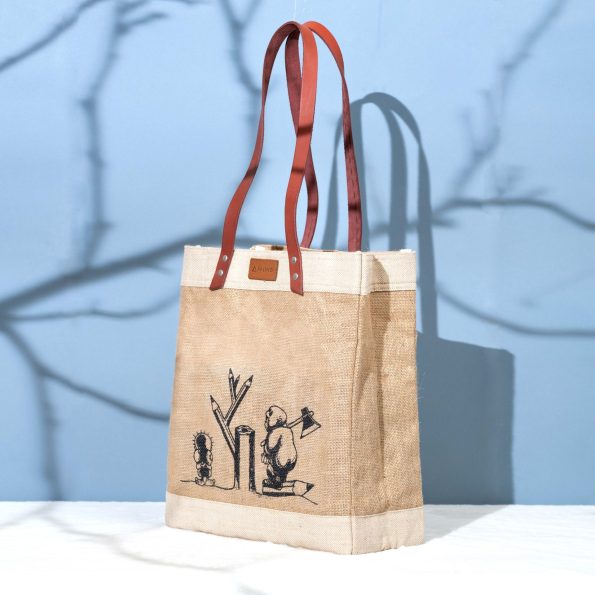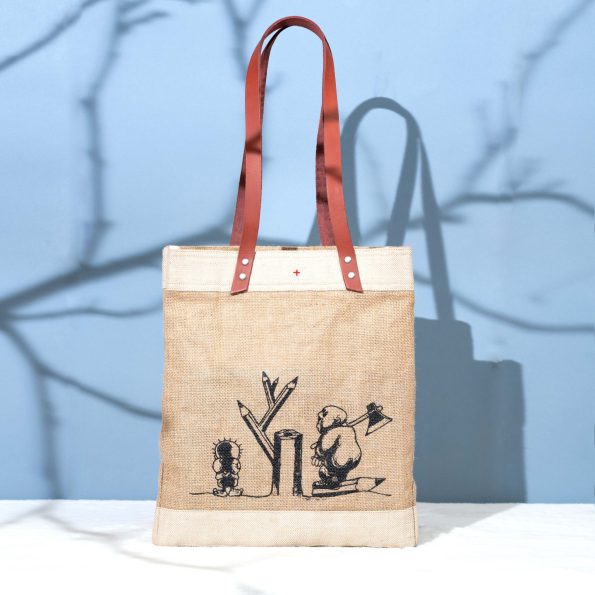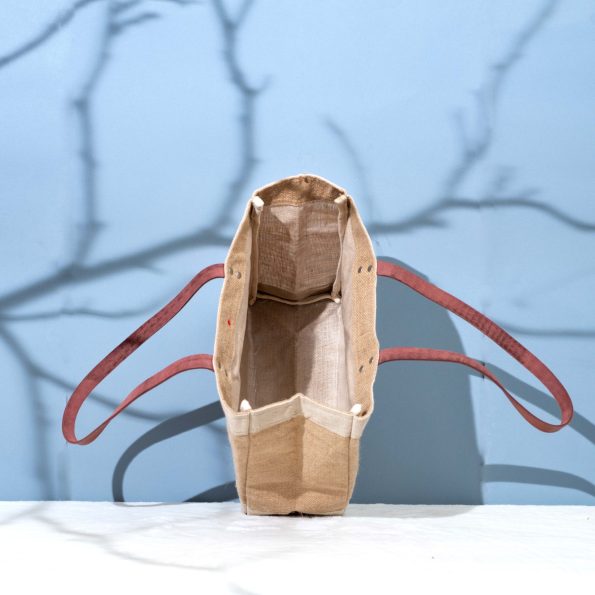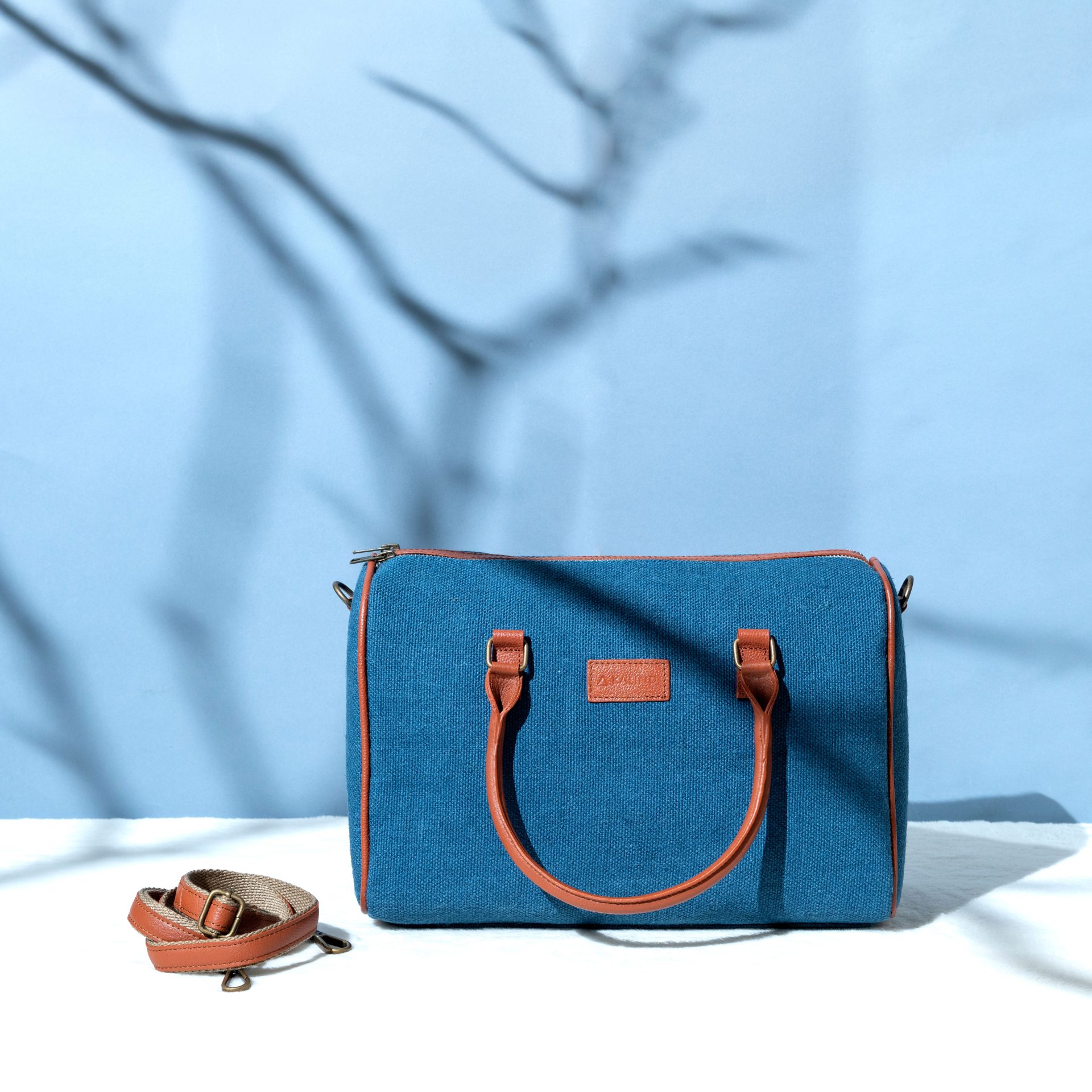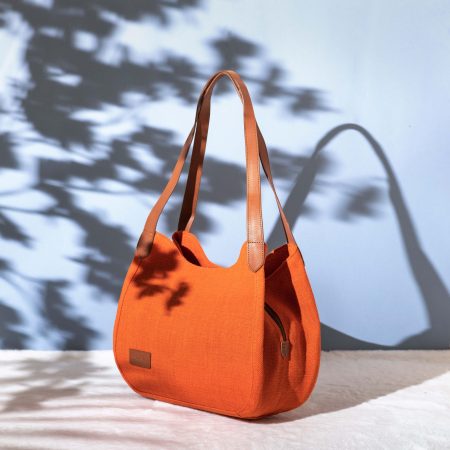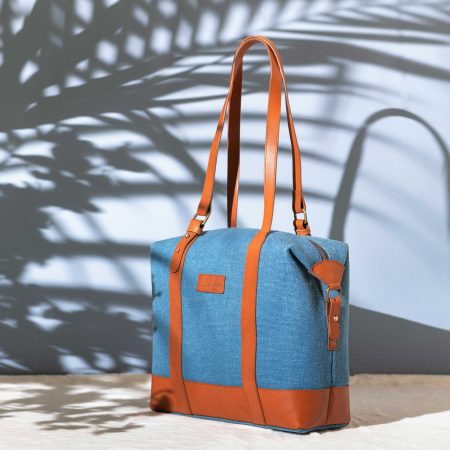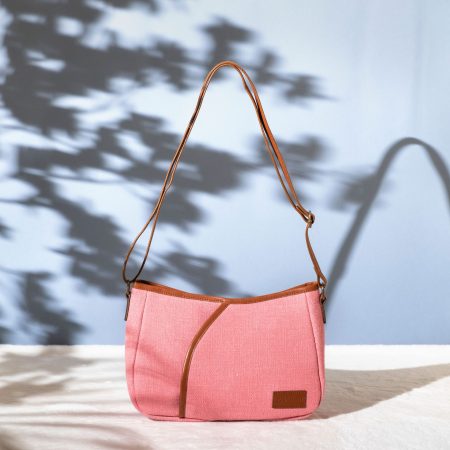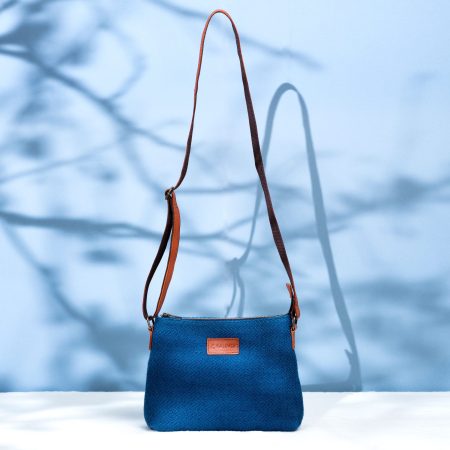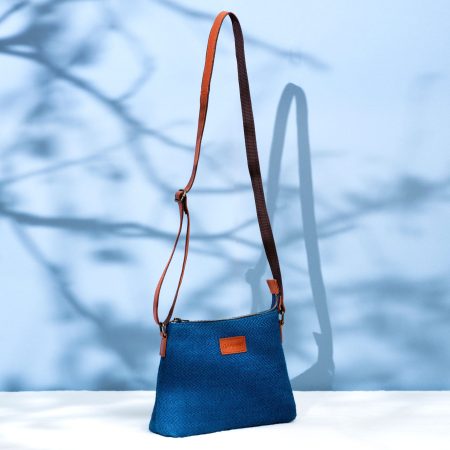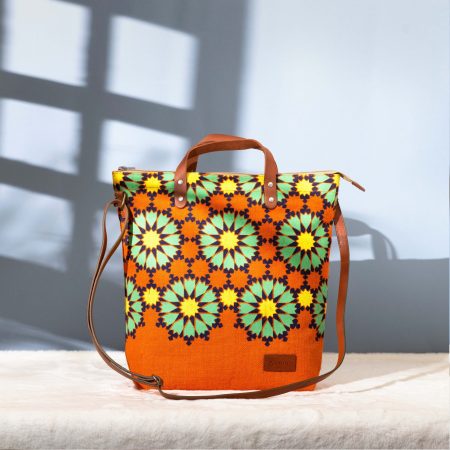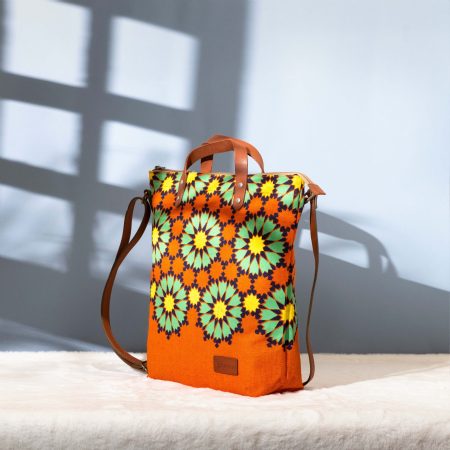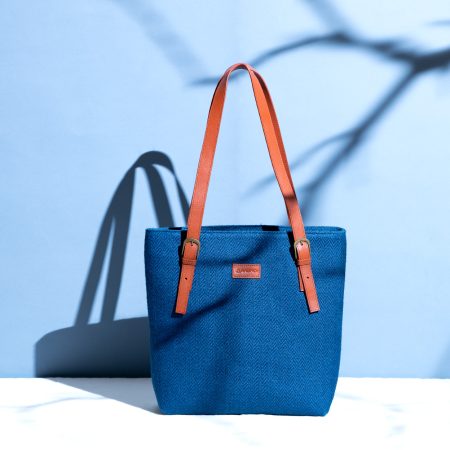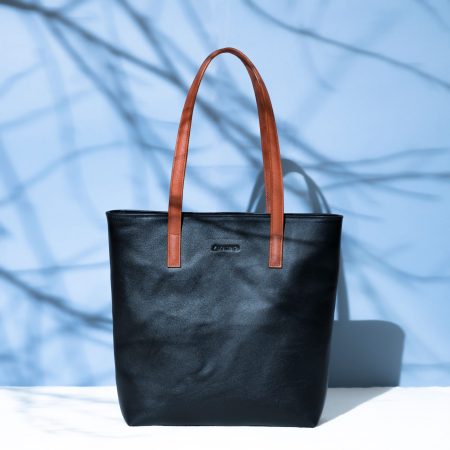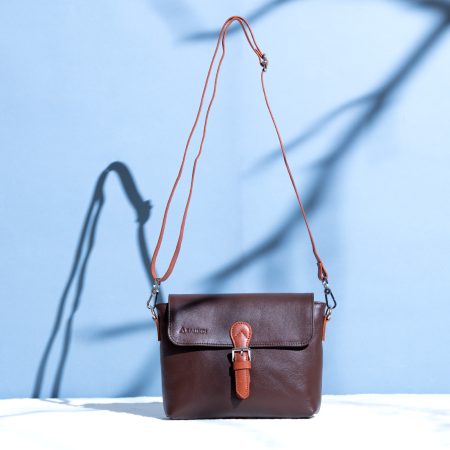Shibsha
৳ 400.00
To ease your daily commute, Kalindi designed this tote bag named Shibsha. It has plenty of space for carrying essentials. Because of its lightweight, it is comfortable to carry on the shoulder.
– Measurements: 15″×12.5″×5″
– Material: High quality jute fabric and vegetable tanned leather.
আপনার চলার পথকে সহজ করতে কালিন্দী নিয়ে এলো এই টোট ব্যাগটি। প্রয়োজনীয় জিনিসপত্র বহনের জন্য এতে রয়েছে অনেক স্পেস। ওজনে হালকা হওয়ায় কাঁধে ঝুলিয়ে বহন করাটা আরামদায়ক।
– সাইজঃ ১৫”×১২.৫”×৫”।
– মেটেরিয়ালঃ পাট এবং লেদার।
Out of stock
- Delivery & Return
Delivery
আমরা পুরো বাংলাদেশে হোম ডেলিভারি দিয়ে থাকি। ডেলিভারির সময় ২-৫ দিন। পণ্যের আকার, ওজন এবং আপনার লোকেশনের উপর নির্ভর করে ৮০-১৫০ টাকা ডেলিভারি চার্জ প্রযোজ্য।Return
আমরা প্রতিটি পণ্য খুবই যত্নের সাথে কোয়ালিটি কন্ট্রোল করি। পণ্যটি নেওয়ার সময় অবশ্যই ভালোভাবে চেক করে নেওয়ার অনুরোধ রইল। এর পরও যদি কোন সমস্যা হয় তাহলে ডেলিভারির ৭ দিনের মধ্যে রিফান্ডের (শর্ত সাপেক্ষে) ব্যবস্থা আছে।Help
যেকোন প্রয়োজনে আমাদের সাথে যোগাযোগ করুন। Facebook: https://www.facebook.com/kalindi.com.bd Phone: +880 1810151890 Email: [email protected]
শিবসা
সুন্দরবনের অন্যতম বৃহৎ নদী শিবসা। মোংলা-চালনা বন্দরের কাছে পশুর নদী দুটি শাখায় বিভক্ত হয়ে পশ্চিম শাখা শিবসা নামে সুন্দরবনের মধ্য দিয়ে প্রবাহিত হয়েছে। মোহনার কাছে কুঙ্গা নাম ধারণ করে পরে সাগরে মিশেছে। শিবসা বা কুঙ্গার তীরে হিরন পয়েন্ট অবস্থিত। শিবসা নদীর উৎপত্তি মূলত খুলনা জেলার দাকোপ উপজেলার রাডুলীর কাছে কপোতাক্ষ নদ থেকে। দাকোপ, পাইকগাছা ও কয়রার পাশ দিয়ে প্রবাহিত হয়ে দক্ষিণমুখী হয়ে বঙ্গোপসাগরে মিশেছে। গড়ইখালি ত্রিমোহনায় শিবসার রূপ ভয়ংকর। বাড়ুলিয়া, হাড়িয়া, বুনাখালি, গাড়খালি, কড়ুয়া, গ্যাংরাইল, হড্ডা, নালজল্লা, ঢাকি, বাদুরগাছা, দেলুটি, মানস, কয়রা এবং আরো কয়েকটি নদী বিভিন্ন দিক থেকে এসে শিবসাকে প্রবল গতিসম্পন্ন নদীতে পরিণত করেছে। ঢাকি নদী ভদ্রা ও শিবসা নদী দুটিকে পরস্পরের সঙ্গে সংযুক্ত করেছে। ত্রিকোণ দ্বীপের উত্তরে শিবসা নদী মারজাট্টা বা কুঙ্গার সঙ্গে মিশে সমুদ্রে বিলীন হয়েছে। এই শিবসা নদীর পূর্ব তীরেই সুন্দরবনের বিখ্যাত শেখেরট্যাক ও কালীবাড়ি নামক প্রাচীন শহরের ভগ্নাবশেষ অবস্থিত। শিবসার পশ্চিম তীরে অনেকগুলো ছোট-বড় দ্বীপ জঙ্গলে পরিণত হয়েছে। শিবসা উৎপত্তির পর প্রায় ২৭ কিমি পাইকগাছা উপজেলার ভেতর দিয়ে প্রবাহিত হয়ে অবশিষ্ট পথ পাইকগাছা ও দাকোপ উপজেলার সাধারণ সীমানা নির্ধারণ করে দক্ষিণে প্রবাহিত হয়েছে।
দেলুটার কাছে কপোতাক্ষ নদ ও ভদ্রা নদী থেকে উৎপন্ন শিবসা দক্ষিণে প্রবাহিত হওয়ার পথে তিনটি মুখে বিভক্ত হয়েছে- মন্দাবাড়ি, মরজাল ও হান্দুয়াস নামে। তারপর মুরঘাটায় আবার মিলিত হয়েছে। এটি হানসুরার মাধ্যমে আড়পাঙ্গাশিয়ার সঙ্গে যুক্ত।
শিববাটি পর্যন্ত শিবসা এসেছে দক্ষিণ দিকে সোজা। তারপর পাইকগাছার কাছে এসে হঠাৎ বাঁক নিয়েছে পূর্ব দিকে। এরপর কিছুটা এঁকেবেঁকে যাবার পর উত্তর দিক থেকে মিশেছে হরিয়া, গ্যাংরাইল, নরা, দেলুটি, হাবরখালি, বাদুরগাছা নদী। এতগুলো নদীর পানি শিবসাকে উদ্দাম-উত্তাল নদীতে পরিণত করেছে। তারপর দক্ষিণমুখী শিবসার সঙ্গে গড়াইখালির কাছে পূব দিক থেকে ঢাকি ও পশ্চিম দিক থেকে মিনহাজ এসে মিশেছে। চালনার কাছে ঢাকি নদীর নাম চুনকুড়ি। তারপর এসে মিলিত হয়েছে ভদ্রা। গড়াইখালির কাছে খসিয়াখালি শিবসার সঙ্গে কপোতাক্ষের সংযোগসাধন করেছিল কয়রা নদী দিয়ে।
শিবসা নদীর দৈর্ঘ্য ১০০ কিমি। প্রস্থ পাইকগাছা এলাকায় ৩ কিমি । গভীরতা ১৭ মিটার আর নদী অববাহিকার আয়তন ৪০০ বর্গ কিমি। ফেব্রুয়ারি মাসে পানিপ্রবাহের পরিমাণ ১৫০০ ঘনমিটার থাকে। এ সময় পানির গভীরতা থাকে ১২ মিটার। আর আগস্ট মাসে বর্ষা মৌসুমে পানিপ্রবাহ বাড়ে। তখন পানিপ্রবাহের পরিমাণ দাঁড়ায় ৬০ হাজার কিউসেক। এ সময় নদীতে পানির গভীরতা হয় ১৭ মিটার। নদীতে নিয়মিত জোয়ার-ভাটা হয়। বর্ষাকলে কয়েক মাস ছাড়া নদীটির পানি প্রায় সারা বছরই লবণাক্ত থাকে।
পাইকগাছার ব্যবসা-বাণিজ্য সম্প্রসারণে এ নদীর অবদান অনেক। এই নদী দিয়ে কম খরচে মালামাল আনা-নেওয়া হতো। তবে বর্তমানে ৮৫ কিলোমিটার শিবসা নদীর প্রায় ৩০ কিলোমিটার পলিমাটি ভরাট হয়ে সমতল ভূমিতে পরিণত হয়েছে। বিস্তীর্ণ অঞ্চল জুড়ে জেগে ওঠা চরে নতুন ঘাস জন্মে পরিণত হয়েছে গোচারণ ভূমিতে। জেগে ওঠা চরে প্রাকৃতিকভাবে গেওয়া, গোলপাতাসহ বিভিন্ন প্রজাতির গাছ জন্মায়।
Shibsa
The Shibsa River, one of the largest rivers in the Sundarbans, branches off from the Pashur River near the Mongla-Chalna port. The western branch, known as Shibsa, flows through the Sundarbans and eventually meets the sea, taking on the name Kunga near its estuary. Hiron Point is located along the banks of Shibsa or Kunga. The Shibsa River primarily originates from the Kopotakkho River near Raduli in Dacope Upazila, Khulna district. Flowing past Dacope, Paikgachha, and Koyra, it heads southward into the Bay of Bengal. At the Garikhali Trimohaan (confluence), Shibsa becomes quite formidable. It is strengthened by numerous rivers from various directions, including Barulia, Haria, Bunakhali, Gardkhali, Karua, Gangrail, Hadda, Naljalla, Dhaki, Badurgacha, Deluti, Manas, and Koyra. The Dhaki River connects both the Bhadra and Shibsa rivers. North of the triangular island, the Shibsa merges with Marjat or Kunga and then flows into the sea. The famous ancient towns of Shekhertek and Kalibari in the Sundarbans are located on the eastern bank of the Shibsa River. Several small and large islands on its western bank have turned into forests. After originating, the Shibsa flows about 27 kilometers through Paikgachha Upazila and then continues south, forming the common boundary between Paikgachha and Dacope Upazilas.
Near Deluti, the Shibsa, originating from the Kopotakkho and Bhadra rivers, splits into three branches: Mandabari, Morjal, and Handuas. These branches merge again at Murghata and connect to the Arpangashia River via Hansura. The Shibsa flows straight south until Shibbati and then suddenly turns east near Paikgachha. After winding a bit, it receives waters from the Haria, Gangrail, Nora, Deluti, and Habrkhali rivers from the north, making it a turbulent river. Southward, near Garikhali, the Shibsa receives water from the Dhaki River to the east and the Minhaj River to the west. Near Chalna, the Dhaki River is called Chunnakuri, and it meets the Bhadra. Near Garikhali, the Khasiyakhali River connects the Shibsa with the Kopotakkho through the Koyra River.
The Shibsa River is 100 kilometers long, with a width of 3 kilometers in the Paikgachha area. It has a depth of 17 meters and a basin area of 400 square kilometers. In February, the water flow is around 1,500 cubic meters, with a depth of 12 meters. During the monsoon in August, the water flow increases to 60,000 cusecs, and the depth reaches 17 meters. The river experiences regular tidal cycles and remains saline almost year-round, except for a few months during the rainy season.
The Shibsa River has significantly contributed to the expansion of trade and commerce in Paikgachha. Goods were transported cost-effectively along this river. However, approximately 30 kilometers of the 85-kilometer-long Shibsa River have silted up, turning into flat land. The newly emerged chars have become grazing lands, with natural growth of trees like Gewa and Golpata.
Related Products
A light load eases the journey. And to make your carry-on bag itself lighter, Kalindi has designed this bag named “Sankha”.
You can choose the “Sankha” bag as your travel companion due to its lightweight and lots of space for carrying goods.
– Measurements: 9.5” × 11.5” × 4.5”
– Material: Jute fabric and leather.
হালকা বোঝা চলার পথকে সহজ করে। এবং আপনার বোঝা বহনকারী ব্যাগটি নিজেই যাতে হালকা হয় সেজন্য কালিন্দী তৈরি করেছে “শঙ্খ ” নামের এই ব্যাগটি। মালামাল বহনের জন্য অনেক স্পেস এবং লাইট ওয়েট হওয়ার কারনে আপনার ভ্রমণ সঙ্গী হিসেবে বেছে নিতে পারেন “শঙ্খ” ব্যাগটিকে।
– সাইজঃ ৯.৫” × ১১.৫” × ৪.৫”।
– মেটেরিয়ালঃ জুট এবং লেদার।
Out of stock
কালিন্দী’র ব্যাগসম্ভারে নতুন সংযোজন ‘তিস্তা’। আপনার অফিস, ঘুরাঘুরি কিংবা সংক্ষিপ্ত ভ্রমণের সঙ্গী করতে পারেন এই ব্যাগটিকে।
– সাইজ: ১০”×৪.৫”×১২”।
– ম্যাটেরিয়াল: পাট এবং ভেজিটেবল ট্যানড লেদার।
– চারটি ভিন্ন ভিন্ন রঙে পাওয়া যাচ্ছে।
Out of stock
জলপদ্মের মোটিফে কালিন্দীর সংযোজন জুট ব্যাগ ‘লিলি’। শাড়ি কিংবা কূর্তি, অফিস অথবা চা আড্ডায়, যে কোনো পোশাক এবং যে কোনো জায়গায় অনায়াসে মানিয়ে যাবে এই ব্যাগটি। উন্নত মানের পাটের কাপড় দিয়ে তৈরি এই ব্যাগটি দেখতে ছোট হলেও ভেতরের জায়গায় ধরে যাবে আপনার টুকিটাকি বিশ্ব।
ওজনে হালকা হওয়ায় কাঁধে ঝুলিয়ে বহন করাটা হবে বেশ আরামদায়ক। এই সাইড ব্যাগটি ক্রস বডি হিসাবেও ব্যবহার করা যায়।
– সাইজ: ৮”×১১”×৪”।
– ম্যাটেরিয়াল: ১০০% পাট এবং লেদার স্ট্র্যাপ।
Out of stock
Tote bags are very popular among women for everyday use. Especially, it has a lot of space and can carry many things at once. This bag is lightweight but can perform heavy duty when needed.
– Measurements: 14” × 14.5” × 4”.
– Available in two different colors.
– Material: High quality jute fabric and vegetable tanned leather.
কালিন্দীর ক্রেতাদের চাহিদার কথা মাথায় রেখে “চিত্রা” ব্যাগটির নতুন সংস্করণে জিপার যোগ করা হয়েছে।
দৈনন্দিন ব্যবহারের জন্য সব মেয়েদের কাছে টোট ব্যাগ খুব জনপ্রিয়। স্পেশালি এতে অনেক জায়গা থাকে এবং একসাথে অনেক কিছু ক্যারি করা যায়। ওজনে হালকা কিন্তু মালামাল বহনের দিক থেকে প্রয়োজনে কঠিন দায়িত্ব পালন করতে পারে এই ব্যাগটি।
রঙের বৈচিত্রের দিক থেকে ব্যাগটির নাম রাখা হয়েছে- “চিত্রা”।
– সাইজঃ ১৪” × ১৪.৫” × ৪”।
– দুইটি রঙে পাওয়া যাচ্ছে।
– মেটেরিয়ালঃ পাটের ফেব্রিক এবং লেদার।
আপনার ঘরের বাইরে বের হওয়ার প্রস্তুতিতে টুকিটাকি প্রয়োজনীয় সব জিনিসই বহন করার উপযোগী জায়গা রেখে ব্যাগটির ডিজাইন করা হয়েছে। ‘ইছামতী’ একটি ক্লাসিক ভ্যানিটি ব্যাগ, যেটি হতে পারে আপনার নিত্যদিনের সঙ্গী।
– ম্যাটেরিয়ালঃ ১০০% পাট।
– সাইজঃ ১৩” × ১১.৫” × ৪” ইঞ্চি।
ভ্রমণ অথবা রেগুলার ব্যবহারের জন্য ব্যাকপ্যাক আরামদায়ক ক্যারি ব্যাগ হিসেবে সুপরিচিত।এর একটি উল্লেখযোগ্য কারন এই ব্যাগগুলোতে ডাবল হ্যান্ডেল থাকে,এবং তা কাঁধে বহন করা যায়।কাঁধে বহন করায় ব্যাগের মূল ভার পিঠের উপর ছড়িয়ে যায়,যার ফলে ব্যাগ ক্যারি করতে কষ্ট কম হয়।
নতুন বছরে কালিন্দীতে যোগ হলো “কংস” নামের এই ব্যাকপ্যাকটি।
– সাইজ: ১৪” × ১১” × ৫”
– ম্যাটেরিয়াল: জুট এবং লেদার।
সিম্পল, একই সাথে স্টাইলিশ পাটের ব্যাগ “পায়ারা”। পার্টি, অফিস গোয়িং, অথবা রেগুলার ব্যবহার এর জন্য পার্ফেক্ট একটি ব্যাগ। এছাড়া ফ্যাশনেবল এই ব্যাগটি মানিয়ে যাবে যে কোনো বয়সের সাথে।
– সাইজ: ১১” × ১০” × ৫”।
– মেটেরিয়ালঃ ১০০% পাট এবং লেদার।
Out of stock
ছোটো এবং হালকা ওজনের ক্রস বডির ব্যাগ ‘সন্ধ্যা’। ব্যাগটি দেখতে ছোট হলেও ভেতরের জায়গায় ধরে যাবে আপনার টুকিটাকি বিশ্ব। উন্নতমানের মসৃণ লেদার দিয়ে তৈরি এই ব্যাগটি মানিয়ে যাবে যে কোনো পোশাকের সাথে।
– সাইজ: ৭.৫”×৯”×২” ইঞ্চি।
– মেটেরিয়ালঃ লেদার।





